
杜宇慧个人网页---智能医学图像分析
地址:中国, 太原
Yuhui Du*, Godfrey D Pearlson, Dongdong Lin, Jing Sui, Jiayu Chen, Mustafa Salman, Carol A. Tamminga, Elena I. Ivleva, John A. Sweeney, Matcheri S. Keshavan, Brett A. Clementz, Juan Bustillo, Vince D. Calhoun. Identifying dynamic functional connectivity biomarkers using GIG-ICA: application to schizophrenia, schizoaffective disorder and psychotic bipolar disorder. Human Brain Mapping, 2017, 38(5), 2683-2708. (Top期刊, 中科院SCI分区:二区,影响因子:5.038)
时间:2019-06-12 16:08:02 来源: 点击:[1745]
Abstract
Functional magnetic resonance imaging (fMRI) studies have shown altered brain dynamic functional connectivity (DFC) in mental disorders. Here, we aim to explore DFC across a spectrum of symptomatically‐related disorders including bipolar disorder with psychosis (BPP), schizoaffective disorder (SAD), and schizophrenia (SZ). We introduce a group information guided independent component analysis procedure to estimate both group‐level and subject‐specific connectivity states from DFC. Using resting‐state fMRI data of 238 healthy controls (HCs), 140 BPP, 132 SAD, and 113 SZ patients, we identified measures differentiating groups from the whole‐brain DFC and traditional static functional connectivity (SFC), separately. Results show that DFC provided more informative measures than SFC. Diagnosis‐related connectivity states were evident using DFC analysis. For the dominant state consistent across groups, we found 22 instances of hypoconnectivity (with decreasing trends from HC to BPP to SAD to SZ) mainly involving post‐central, frontal, and cerebellar cortices as well as 34 examples of hyperconnectivity (with increasing trends HC through SZ) primarily involving thalamus and temporal cortices. Hypoconnectivities/hyperconnectivities also showed negative/positive correlations, respectively, with clinical symptom scores. Specifically, hypoconnectivities linking postcentral and frontal gyri were significantly negatively correlated with the PANSS positive/negative scores. For frontal connectivities, BPP resembled HC while SAD and SZ were more similar. Three connectivities involving the left cerebellar crus differentiated SZ from other groups and one connection linking frontal and fusiform cortices showed a SAD‐unique change. In summary, our method is promising for assessing DFC and may yield imaging biomarkers for quantifying the dimension of psychosis.

 您当前的位置:
您当前的位置: